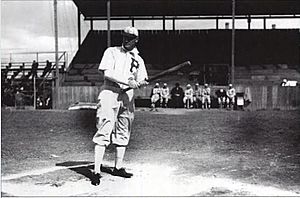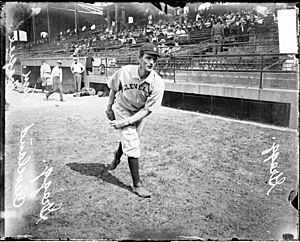History of baseball in Portland, Oregon facts for kids
Portland, Oregon, has a long and exciting history with baseball. Many teams have called Portland home, going all the way back to the 1800s!
Contents
- Early Baseball in Portland: 1866–1883
- A New Era for Portland Baseball: 1901–1902
- The Pacific Coast League Years: 1903–1917
- Back to the Pacific Coast League: 1919–1972
- Independent Baseball in Portland: 1973–1977
- AAA Baseball Returns to Portland: 1978–1993
- Northwest League Baseball: 1994–2000
- The Beavers Return Again: 2000–2010
- Attempts to Bring Baseball Back: 2011–2012
- The Northwest League Returns: 2013–Present
Early Baseball in Portland: 1866–1883
The very first organized baseball team in the Pacific Northwest started in Portland. It was called the Pioneer Baseball Club of East Portland, and it was formed on May 28, 1866. This club was for gentlemen like merchants, doctors, lawyers, and farmers. Professional players were not allowed to join. Members even had to pay to be part of the club! Many other clubs soon started up around Portland.
In February 1868, the Pioneers invited other clubs to a meeting. They wanted to form a bigger group called The Oregon, Washington and Idaho Territories Association of Base Ball Players. Five clubs joined: the Pioneers, the Portland Spartans, the Highland Baseball Club, the Clackamas Club from Oregon City, and the Occidentals from Vancouver, Washington. These teams used rules that were similar to those used by the National Association of Base Ball Players in 1863.
A New Era for Portland Baseball: 1901–1902
In the spring of 1901, a new baseball park was built. It was located at NW Vaughn Street and NW 24th Avenue and became known as Vaughn Street Park. This year also saw the return of the Pacific Northwest League. A group of business people, led by William H. Lucas, created the Portland Baseball Club. They put together a team called the Webfooters to play in the league. This team included future major league star Joe Tinker and won the League Championship in their very first season.
In 1901, the National Association of Professional Baseball Leagues was created. This group later changed its name to Minor League Baseball in 1999. Because of this, the Pacific Northwest League and the Portland Webfoots became a Class B minor league in 1902. The team finished fourth in the league that year.
On December 10, 1902, Henry Harris, who owned the San Francisco team in the California League, made a big announcement. He said that the Portland team and a new team from Seattle would join the California League. Together, they would create the Pacific Coast League.
The Pacific Coast League Years: 1903–1917
The Portland Baseball Club started playing in the Pacific Coast League (PCL) in 1903. They were first known as the Portland Browns. In their first PCL season, Portland finished fifth. In 1904, the Portland team had a tough year, losing 136 games. This set a PCL record for the most losses in a season.
The old Pacific Northwest League tried to compete with the new Pacific Coast League. They added teams in Los Angeles and San Francisco and changed their name to the Pacific National League. The new Portland team in this league, called the Green Gages, only played until July 1. Then they moved to Salt Lake City and became the Elders. By the end of 1905, this old league was gone for good.
The PCL continued, and so did the Portland Baseball Club. After the 1904 season, the PCL joined the National Association of Professional Baseball Leagues. This made Portland a Class A league team, which is now called AAA Baseball. Also after 1904, Portland outfielder Walter McCredie and his uncle Judge William McCredie bought the team. The new owners changed the team's name to the Giants for the 1905 season. Walter became the team's manager while still playing.
After a newspaper contest, the team was renamed the Beavers for the 1906 season. Oregon is known as the "Beaver State," so the name was a perfect fit! The newly named Portland Beavers won their first PCL championship in 1906. They finished 19½ games ahead of the second-place team, Seattle. In 1906, Beavers player Mike Mitchell led the league in home runs. He only hit six home runs, which was a record for the fewest home runs hit by a league leader!
The Beavers finished last in 1907. They came in second place in both 1908 and 1909. In 1910, Portland won another championship. Their success was thanks to the amazing pitching of Vean Gregg and Gene Krapp. Gregg had a 32-18 record and 14 shutouts, while Krapp had a 29-16 record. Portland won the PCL championship again in 1911, with four pitchers who each won 20 games or more.
In 1912, Judge McCredie helped build a new grandstand at Vaughn Street Park. It had 12,000 seats. His obituary later said that the ballpark was "the sensation of baseball." This was because it was the first minor league park to have individual grandstand seats. Other team owners thought this was too fancy and a risky new idea. In 1912, the top minor league level became Class AA, and the PCL and the Portland Beavers moved into this higher classification.
During the 1910s, the Beavers worked with other teams. From 1911 to 1914, the Portland Beavers had their own farm team. This team played in the Northwest League. The Class B team shared Vaughn Street Park. They were called the Portland Pippins in 1911 and then the Portland Colts in 1912. In 1914, the Colts moved to Seattle and became the Ballard Pippins before the team stopped playing. Portland also had a friendly relationship with the Cleveland Indians. Many future major league stars played in Portland to improve their skills.
In 1913 and 1914, Portland played very well, winning the championship in both seasons. The 1915 Beavers had a great player named Stan Coveleski, but the team didn't do well. This started a tough period for the team that lasted over ten years. This year also ended their relationship with the Cleveland Indians. When America entered World War I, travel became difficult. Because of this, the Beavers left the PCL for the 1918 season. They played instead in the Class B Pacific Coast International League. The team was called the Portland Buckaroos. Their season was cut short on July 7 because of the war, but they finished in second place. The PCL also stopped playing just a week later due to travel problems.
Because the Beavers left the PCL, the league offered a team to Sacramento, California. This new team, the Sacramento Senators, could be seen as a continuation of the original Portland Baseball Club. The McCredies continued to own the baseball club in Portland.
Back to the Pacific Coast League: 1919–1972
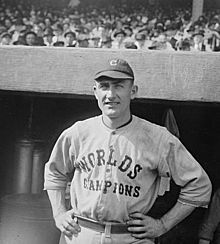
With the McCredies still in charge, Portland was invited to rejoin the PCL in 1919. The team finished seventh, only ahead of Seattle, which was also a new team that year. Portland finished in last place in 1920 and 1921. After the 1921 season, the McCredies sold the team to Walter Klepper. Klepper brought in famous athlete Jim Thorpe, who played for the Beavers in 1922. He paid Thorpe a very high minor league salary of $1000 per month!
After the 1924 season, the Beavers officially became a farm team for a major league team. The owners of the Philadelphia Athletics, John and Tom Shibe, bought the Beavers and Vaughn Street Park. Even with great players like Duffy Lewis (who won the PCL batting title in 1925), Elmer Smith (who led the PCL in home runs in 1926 and all minor league baseball in 1927), and Ike Boone in 1928, the Beavers usually finished in the bottom half of the league.
Rocky Benevento, the longtime head groundskeeper, started working for the Beavers in 1927. Fans loved Benevento so much that they collected money for him in 1956 to send him to the World Series. Benevento retired at the end of the 1966 season and was given a new car. When he passed away in 1969, The Oregonian newspaper said, "He adored kids...he loved baseball...and most of all he loved people." His funeral was packed with people, including Oregon Governor Tom McCall. Benevento worked for the team for 40 years, seeing 30 different managers and five different owners! Today, there's a plaque honoring Benevento where Vaughn Street Park used to be.
In 1929, the Beavers changed their name to the Portland Ducks. They even had a duck on their uniform! Sometimes, they were also called the Portland Rosebuds. The name change didn't bring them better luck, as they finished with a losing record. Rollie Truitt, a longtime radio broadcaster, also joined the team's staff. He worked for the team for 35 years. Truitt later became known as the "Dean of Pacific Coast League broadcasters." In 1930, the team went back to being called the Beavers. However, people sometimes still called them the Ducks for over ten years. The best part of the Beavers' last-place 1930 season was William Rhiel's unassisted triple play, which was the last one recorded in PCL history.
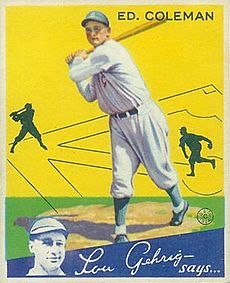
In 1931, team President Tom Turner bought the team. Things started to get better! Ed Coleman led the PCL in hits and runs batted in. The team finished third, winning 100 games. The team kept improving in 1932, winning Portland's first championship since 1914. They finished second in 1933. Turner brought Walter McCredie back to manage the team in 1934. But he passed away early in the season, and the team fell to the bottom half of the league.
After the 1934 season, E. J. Shefter bought the team from Turner. The team got better in 1935, finishing with a winning record. Then, they won the championship in 1936! They finished just 1½ games ahead of Oakland and won the postseason series. In 1937, the Beavers finished fourth. They made it to the playoffs, beating San Francisco before losing to the San Diego team, which had a young player named Ted Williams. The team finished sixth in 1938. From 1939 to 1942, they finished in last place. The 1940 team was very bad, winning only 56 games and losing 122. They were 25 games behind the seventh-place team!
In 1943, William Klepper and George Norgan bought the Beavers. The team had a winning record that season, their first since 1937. The team's management started calling them the "Lucky Beavers." Vaughn Street Park became known as "Lucky Beaver Stadium." During World War II, local radio station KXL sold over $300,000 in war bonds in 1943. This money helped build a bomber for the war that was named "The Lucky Beaver." Even though many baseball players were fighting in the war, the Beavers still improved. They finished second in 1944. In 1945, the Beavers brought another championship to Portland, led by player-manager Marv Owen. Even though they won the championship, the team lost to San Francisco in the first round of the playoffs. After the 1945 season, Norgan bought Klepper's share and became the team's new owner.
In 1946, the Beavers dropped to the bottom half of the league, finishing seventh. In 1947, Eddie Basinski joined the Beavers, and they finished third. They lost to the Los Angeles Angels in the first round of the playoffs. That season, a record 421,000 fans came to watch the team! This record stood for the Beavers until 2001, when AAA Baseball returned to Portland.
In 1948, the team finished fifth, and in 1949, they finished sixth. The 1949 season was important because the Pacific Coast League started to allow players of all races. Frankie Austin and Luis Marques became Beavers players. From 1950 to 1953, the Beavers finished fourth for four years in a row. Clay Hopper, who had managed Jackie Robinson when he played for the Montreal Royals in 1946, became the team's manager in 1952. This year, the Pacific Coast League, including the Portland Beavers, was called an "Open League." This was a step above AAA, and the PCL hoped to be considered a third major league.
Plans for a new ballpark were announced in 1953. The team wanted to build a new stadium in Southeast Portland. However, because of the Korean War and other issues, the stadium was never built. In 1954, the team dropped to the bottom of the league again. After the 1954 season, the team was sold to the public through public stock. This meant 2,400 new owners for the 1955 season! With this change, the Beavers rose to fifth place, only nine games behind first.
In 1956, the Beavers left Vaughn Street Park. They moved into the 25,000-seat Multnomah Stadium, which was later renamed Civic Stadium. Through most of the 1960s, the Beavers were a AAA farm team for the Cleveland Indians. They helped develop future stars like Sam McDowell, Lou Piniella, and Luis Tiant. Later, they were also connected with the Minnesota and Philadelphia major league teams.
Independent Baseball in Portland: 1973–1977
After 1972, when fewer than 92,000 fans came to see the Beavers all season, the team left Portland and moved to Spokane. The Class A Portland Mavericks filled the empty spot left by the Beavers. The Mavericks played in the short-season Northwest League, with games from mid-June through August. They won four division titles in their five years, but they never won the league championship.
AAA Baseball Returns to Portland: 1978–1993
The PCL expanded in 1978 and added a new team in Portland, again calling themselves the Beavers. The new Beavers played in Civic Stadium until 1992. In 1983, the Beavers won the PCL championship! This was Portland's first championship in 47 years. Even though they finished fourth overall that year, the Beavers beat the Edmonton Trappers to win the Northern Division title. Then, they defeated the Albuquerque Dukes in the finals to win the championship.
After the 1993 season, Beavers owner Joe Buzas moved the team to Salt Lake City. They became the Salt Lake Buzz, and later the Stingers. Their current name is the Bees.
Northwest League Baseball: 1994–2000
For the first time since 1899, Portland did not have a baseball team in 1994. However, the departure of the PCL eventually led to the return of the short-season Northwest League. After their first season in 1994, the Class A Bend Rockies moved to Portland in 1995. The Portland Rockies played in Portland for the next six seasons. They were important for the city, as more and more people wanted a major league team. Portland's support for the Rockies helped bring AAA baseball back in 2001.
The Beavers Return Again: 2000–2010
After the 2000 season, the Los Angeles Dodgers and San Diego Padres swapped their AAA teams. The Albuquerque Dukes moved to Portland and became the Beavers, as the San Diego Padres' farm team. As part of this move, Civic Stadium was updated in 2000 and renamed PGE Park. The Portland Rockies moved up the Columbia River to Pasco and became the Tri-City Dust Devils in 2001.
In 2007, owner Merritt Paulson thought about changing the team's name. He wanted to avoid confusion with the Oregon State University Beavers, whose baseball team won national championships in 2006 and 2007. Possible new names and logos were shown, and fans voted on the team's website. "Portland Beavers" won the vote! On January 29, 2008, the team showed off new logos and colors. The Beavers highlighted their connection to past teams by adding "Est. 1903" to their main logo. They also brought back the name "Lucky Beavers" on a patch for their alternate jersey.
In 2009, the city of Portland was given a Major League Soccer (MLS) team for 2011, to be named the Portland Timbers. The Portland City Council agreed to spend $31 million to update PGE Park. It would become a stadium just for soccer and football. The condition was that a new baseball park had to be built in Portland for the Beavers by 2011.
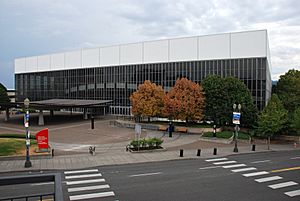
At first, the new ballpark was planned for the site of the Memorial Coliseum. The Coliseum would have been torn down. But many people in Portland were upset about demolishing a landmark. So, Portland mayor Sam Adams suggested a second site in the Rose Quarter area. However, that site was too small. Another location in the Lents neighborhood was also rejected because neighbors had objections.
In June 2009, the Portland City Council voted to separate the soccer and baseball projects. This allowed the PGE Park renovation to go ahead without a baseball stadium plan in place. Other places in the Portland area were considered for the ballpark. None of these ideas went very far.
With no good location in Portland available, Paulson announced in July 2010 that he was selling the team. The Beavers played their last game in Portland on September 6, 2010. They beat the Las Vegas 51s 6–5 in front of a sold-out crowd. The team was eventually moved temporarily to Tucson and renamed the Tucson Padres.
Attempts to Bring Baseball Back: 2011–2012
On August 2, 2011, the Milwaukie, Oregon, city council encouraged its staff to keep trying to bring professional baseball back to the Portland area. It had been reported that the city's economic development director was working with others to build a 4,000-seat ballpark in Milwaukie. This site was near the Portland border. A new MAX Light Rail line was being built nearby, which would make it easy to get to the proposed ballpark.
The Northwest League Returns: 2013–Present
In 2012, it was announced that Hillsboro, a suburb of Portland, had made a deal. The Yakima Bears would move to Hillsboro. Construction on a new, 4,500-seat stadium in Hillsboro began later that year. It was finished in June 2013. This new stadium became the home of the renamed Hillsboro Hops. The Hops replaced the Beavers as Portland's minor league baseball team. The team's first game was a 3–2 loss. Their home opener was special for many reasons: it was the first sellout in team history, with over 4,700 fans; it was the team's and Hillsboro Ballpark's first home run; and most importantly, it was the team's first win!


